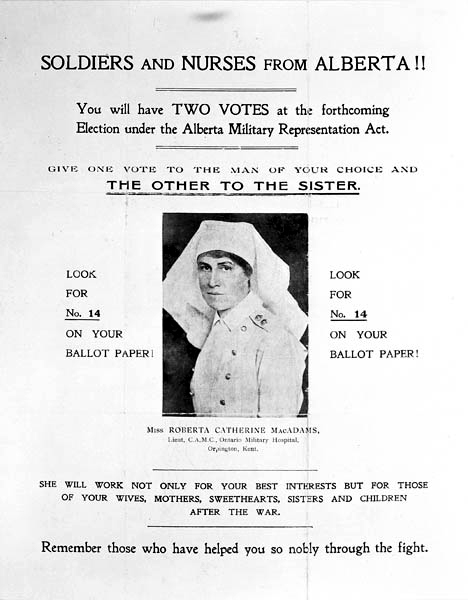Lieutenant Roberta MacAdams – a true trail blazer
By Lookout on Nov 11, 2018 with Comments 0
Michelle Savage, Army Public Affairs ~
You may not know her name, but Lieutenant Roberta Catherine MacAdams improved the dietary health and healing of men and women during the First World War, and also helped pave the way for women in Canadian politics.
Women were not allowed to serve in combat roles during the First World War, but many still made significant contributions, including Lt MacAdams, who served as a dietician in the Canadian Army Medical Corps. It was the first such position.
Documents in her service record tell the story.On some forms the word “him” is scratched out and replaced with a handwritten “her”. A form listing family information asks, “If married, state full name of your wife.” “Husband” was not an option.
Lt MacAdams (sometimes spelled Macadams) was born in Sarnia, Ontario, in 1880. She attended the Ontario Agriculture College and graduated from the Macdonald Institute for Domestic Science (now the University of Guelph) in 1911.
Shortly afterward, she made her way to Alberta and accepted a position with the provincial government as one of the first domestic science instructors – a job that required her to travel to rural communities to teach about health and nutrition.
A report written by MacAdams led to the creation of the Alberta Women’s Institutes, a support network for women living in rural communities, who were often lonely or isolated and had little access to information about health.
As the initial Edmonton Superintendent of Domestic Science, she also helped schools in that city develop classes that advanced the science of nutrition.
In 1916, she enlisted in the Canadian Army Medical Corps and was given the rank of Lieutenant. Although she wore the blue and white uniform of a nurse, she performed the first-ever role of dietician at the Ontario Military Hospital in Orpington, England.
The hospital was built in response to overwhelming casualties and opened in February 1916 with 1,000 beds. Another 1,000 beds were added in 1917 when the hospital was renamed No. 16 Canadian General Hospital. By the end of the war, 30,000 men had been treated there, with 201 deaths.
As a dietician, Lt MacAdams was responsible for ensuring patients and staff were properly nourished, supervising thousands of meals a day. This position required knowledge of what diets are best for helping to heal different injuries, which would have been a significant challenge due to food shortages at the time.
While she was serving in England in 1916, the Alberta government created a special constituency for the 38,000 Alberta soldiers and nurses serving overseas. Each soldier and nurse from Alberta could vote for two candidates in the 1917 provincial election.
This provincial election was the first time the vote was extended to white women in Alberta. It was not until 1960 that all Canadian adults won the right to vote.
MacAdams decided to run as a candidate. Her campaign slogan, “Give one vote to the man of your choice and the other to the sister,” resulted in 4,000 votes.
Thus, on Sept. 18, 1917, she and Robert Pearson were elected as Representatives at Large for the nurses and soldiers overseas. MacAdams was one of the first two women elected to any legislature in the British Empire – Louise McKinney was elected in a southern Alberta riding in the 1917 election.
Her election came at a time when the idea of women becoming involved in politics was still being hotly debated.
MacAdams remained dedicated to helping soldiers. The first piece of legislation she introduced was the “Great War Next-of-Kin Association,” which was intended “to secure economic justice for men and women who have taken part in the Great War.” It passed and she earned the distinction of being the first woman in the British Empire to introduce legislation.
Subsequently, she returned to England and began working for Khaki University, a place for returning soldiers to continue their education. There, she helped organize the female staff.
When the war ended, she served as a chaperone to British war brides travelling to Canada. She was eventually appointed to the Alberta Soldier Settlement, a body which granted land rights to returning veterans. She also used her time in the Legislature to help establish teacher training.
In 1920, she married lawyer Harry Stinson Price and the couple had one son, Robert. She did not seek re-election after serving one four-year term. She died in December 1959 at the age of 79 in Calgary, Alberta.
Edmonton’s Roberta MacAdams School opened its doors in 2016, 100 years after she enlisted – a fitting tribute to a woman who contributed so much to education in Alberta.
Filed Under: Top Stories
About the Author:






